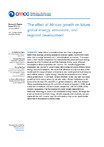Today Africa is a small emitter, but it has a large and faster-than-average growing population and per capita income that could drive future energy demand and, if unconstrained, emissions. This paper uses a multi-model comparison to characterize the potential future energy development for Continental and Sub-Saharan Africa under different assumptions about population and income. Our results suggest that population and economic growth rates will strongly influence Africa’s future energy use and emissions. We show that affluence is only one face of the medal and the range of future emissions is also contingent on technological and political factors. Higher energy intensity improvements occur when Africa grows faster. In contrast, climate intensity varies less with economic growth and it is mostly driven by climate policy. African emissions could account for between 5% and 20% of global emissions, with Sub-Saharan Africa contributing between 4% and 10% of world emissions in 2100. In all scenarios considered, affluence levels remain low until the middle of the century, suggesting that the population could remain dependent on traditional bioenergy to meet most residential energy needs. Although the share of electricity in final energy, electric capacity and electricity use per capita all rise with income, even by mid-century they do not reach levels observed in developed countries today.
CMCC Divisions


